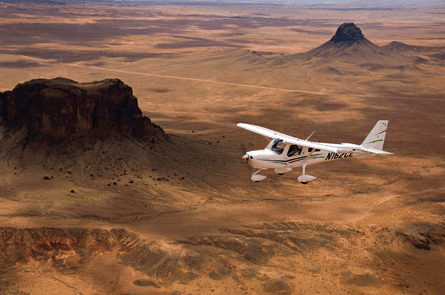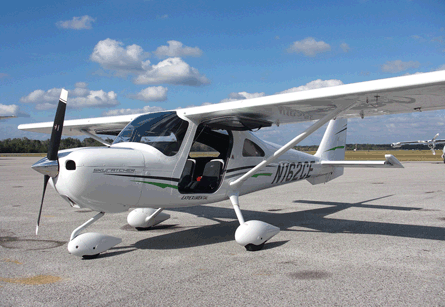The newest and most demure member of the Cessna family, the all-metal Teledyne Continental-powered C162 Skycatcher, "sings" to its pilots when on final approach.
Thanks to some combination of the 40° full flaps and the clean, highly loaded and strutted metal wing, this factory-built light sport aircraft (S-LSA), when slipping back to the surly bonds at 55kt (100km/h) over-the-fence speed, resonates and hums like a half-empty Coke bottle when you blow air over the sipping end.
The airy tune is a nice metaphor for the aircraft itself, larger than it would seem on the inside and pleasant as a song to fly, yet penned with a few dissonant chords.
 |
|---|
© CessnaThe third Skycatcher prototype has several modifications to help pilots avoid or recover from unintentional spins |
I flew the third prototype Skycatcher as Cessna's guest on 2 November at the Tampa Executive airport, several days before the start of the annual Aircraft Owners and Pilots Association gathering in the same city. The first two prototypes, built by Cessna in Wichita, were lost in full-power, cross-controlled spin accidents during the testing phase. Pilots were unscathed in the events, which Cessna says went above and beyond what was required by the American Society of Testing and Materials consensus standards to which S-LSAs are built. A placard in the aircraft I flew (N162CE) warns that intentional spins are not allowed.
The third prototype, which features several modifications to help pilots recover from unintentional spins, used the first wings and tail surfaces built by China's Shenyang Aircraft, the production facility for the Skycatcher, and was the vehicle used to show ASTM compliance.
Cessna is set to deliver the first customer aircraft by year's end, to Rose Pelton, wife of Cessna president and chief executive Jack Pelton, who will attempt to earn her private pilot's licence in the made-in-China, all-metal, high-wing two-seater.
I am not sure what kind of skills Rose will bring to the cockpit, but as someone with commercial and flight instructor ratings, I found the Skycatcher an easy ride for certificated pilots and it is likely to be for students too, but not without a few caveats.
First impressions will be important for the S-LSA because it is meant to become a key player in the next generation of initial flight-training aircraft, picking up where the Cessna 152 left off when production of the 110hp (82kW) Lycoming-powered two-seater ended in 1985. Cessna built 7,500 Cessna 152s, and before that, more than 22,000 of the 100hp Continental-powered C150 family.
With the Skycatcher, Cessna is attempting, in part, to capture a new, vibrant primary training market spawned by the introduction of the light sport category of pilot and aircraft in 2004. Cessna notes that student pilot starts in the USA appear to be on the rebound after decreasing over the past six decades.
Key to market differentiation will be reputation and cost, says the airframer. With its brand already strong, based on having built an industry-leading 190,000 piston- and turbine-powered aircraft since the 1920s, Cessna set out to offer a better aircraft for less money.
Of the dozens of makers of S-LSA aircraft, competition is fiercest among just three or four, one of which is Italian airframer Tecnam, which is targeting market share in the USA with its all-metal Eaglet light sport. Tecnam was third in overall sales in the USA between January 2008 and April 2009, with 49 aircraft delivered. Ahead of Tecnam were composite aircraft manufacturers Remos and FlightDesign, with 73 and 63 aircraft delivered over the same period, respectively.
Cessna's low-cost quest led it to Shenyang, where its officials say labour rates and a "willingness to step up facilities and tooling" enabled a nicely equipped aircraft to be produced for about $130,000 - between $9,000 and $16,000 less than the nearest competitors with similar options.
The current orderbook stands at more than 1,000 units, says Cessna. Hundreds of these orders are from Cessna pilot centres (CPCs), although the company says the company's training and sales arms were not required to buy two each, as was rumoured in the industry. "When we launched the Skycatcher at Oshkosh in 2008, we didn't want one CPC to get a whole bunch while others got none," says a Cessna spokesman, "so we limited them to two aircraft each."
Cessna plans to ramp up production to 700 aircraft a year at some point, but it continues to evaluate plans on how many will be produced in 2010 and 2011. Aircraft for the US market - 61% of today's orders - will be assembled and flight-tested in China, then disassembled and shipped to delivery centres in South Carolina, Nevada and Kansas.
At first sight, the Skycatcher is welcoming to the eye - it simply looks fun to fly - and it's quite easy to climb into, given its upward-swinging gull-wing left and right doors and 112cm (44in)-wide cabin, the same size as the Cessna 206 and 11% wider than the C152's cabin. The Tecnam's cabin comes in at 114cm, slightly wider than the Cessna's but with a traditional front-hinged doors and floor-mounted stick, curved to allow easier entrance.
Also making an easy entrance is the Skycatcher's distinctive control stick, a hybrid between a conventional yoke and a floor-mounted control stick. The aircraft's two L-shaped control columns translate left and right for aileron control and slide in and out for elevator actuation. On the top of the yoke are switches for push-to-talk activation and pitch trim, which is controlled via an electric actuator in the horizontal stabiliser driving a trim tab on the left side of the elevator.
My initial instinct was to try to twist the handle left and right for roll control, a not uncommon tendency, says Cessna's chief pilot for piston engine operations, Kirby Ortega, my instructor for the day. Although the stick ultimately proved to be very intuitive, it will be interesting to learn what first-time Skycatcher pilots think of traditional control yoke set-ups when they transition to larger Cessna aircraft.
 |
|---|
© John Croft/Flightglobal |
Fuel gauges are located inside the cabin near the wing roots on each side, with float-based indicators that show a ground and in-flight quantity. Ortega noted that we had about 23 litres (6USgal) on one side and four on the other, enough for about 2h of flying based on the normal 19 litres/h burn rate of the Continental engine. Even with the lower fuel levels, the luggage-less 162 with Ortega and I, each weighing about 82kg (180lb), was at maximum gross weight according to the weight and balance computation on the Garmin G300 avionics unit.
The capacity limits will make for tough decisions on options. N162CE carried about 13kg in options, including 4kg for wheel fairings and 5kg for the aluminium McCauley two-bladed propeller. Adding a ballistic recovery chute, which this aircraft did not have, cuts usable load by a further 16kg. Standard equipment includes one Garmin G300 display, Garmin radio and transponder, electric pitch trim and lighting for visual flight rules night trips. Ortega says McCauley is rumoured to be developing a lighter-weight composite propeller for the Skycatcher.
During the pre-flight procedures inside the aircraft, Ortega noted the aircraft cannot be flown with its doors open, a question that, apparently, is asked a lot. If a door were to pop open in flight - an experience practically every C152 pilot experiences at some time in training - Skycatcher pilots are instructed to slow down to 80kt airspeed and land as soon as possible, rather than try to close the door in flight or continue flying, as is the procedure for the 152.
Walking round the aircraft, Ortega pointed out the LED landing light on the outboard left wing, a technology used for all the aircraft's external lights. Significant changes incorporated after the spin-test failures are noticeable on the outside, including limits on downward aileron motion, an effect created internally in the wing that also prevents pushing the control surfaces upward once pulled downward during the walk-around.
As well as reducing the sweep of the vertical stabiliser, lengthening the rudder and incorporating an underside aft ventral fin, Cessna has also placed a "Gurney" T-strip on the trailing edges of the trim tab to desensitise elevator control to help avoid pilot-induced oscillations in pitch. Engineers changed the position of the optional ballistic recovery parachute from vertical to nearly horizontal in the baggage compartment, again because of lessons learned from the spin accidents.
Engine start procedures are standard, and departure calls for 10° (one notch) of flaps and a lift-off speed of about 50kt. Flaps are mechanically actuated via a somewhat clunky handle located between the pilot seats.
Noise was higher than I expected, largely because of the O-200D's 2,700rpm maximum speed. My previous LSA experience was in the Tecnam Eaglet, which uses a geared Rotax 912ULS that spins the propeller at a relatively quiescent 2,150rpm at full power.
Cessna had originally planned the Rotax engine for the Skycatcher, but switched to the Continental at the request of flight schools, who like the engine's 2,000h versus 1,500h time before overhaul and estimated 40% lower direct operating costs when using 100LL fuel, according to Cessna. The Rotax, which can burn both auto fuel or avgas, weights about 16kg less than the Continental.
In cruise flight at 2,400ft (730m) near Tampa, Ortega coaxed 118kt out of the Skycatcher at 2,700rpm while burning about 23 litres/h. Manoeuvring flight was simple with the control system design, making altitude control during steep turns simple, and power-off stalls a non-event.
Full-power departure stalls can be a bit unnerving because of nose angles that can be as high as 40° if the manoeuvre is entered at too high a speed, says Ortega. As a result, King Schools, which is developing the flight training programme for the Skycatcher, is recommending that pilots begin the power-on stall at 50kt rotation speed with 30° maximum nose angle until the stall occurs. The wing stops flying at 44kt and 40kt in clean and landing configurations, respectively.
On the way back to the airport, Ortego had me fly a standard left-hand pattern, setting up for a short final at 55kt and full (40°) flaps, a configuration that had the Cessna pleasantly singing with its full-flap resonance. The landing that followed was music to my ears too.
Source: Flight International























